610 Search Results for visual support
April 9, 2015
by Carole Zangari -
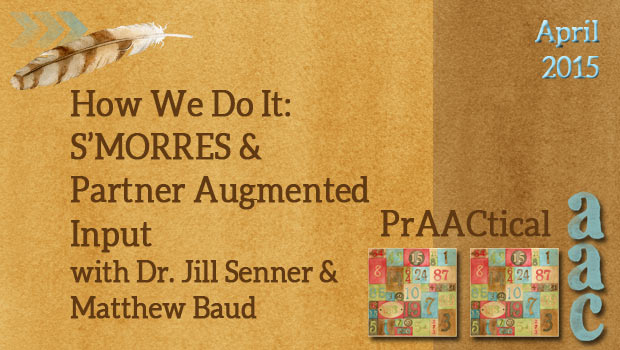
Mnemonics are such a great memory aid, so when Dr. Jill Senner and Matthew Baud offered to share the visual support that they use in their clinical work, I knew it would be of interest to many of you. Combine that with content on partner training, and we have a real treat for you: S’MORRES. Dr. Senner is the owner of Technology and Language Center where she specializes in providing AAC and AT services including assessment, consultation and training, and workshops/lectures. She has presented at numerous national AT conferences and has taught graduate courses in AAC and swallowing disorders. Matthew Baud is the Assistive Technology Coordinator at Niles Township District for Special Education, performing evaluations, trainings and coaching communication partners. Matthew also has his own AAC private practice, and is an adjunct professor at Saint Xavier University where he teaches a graduate course in AAC. In this post, they share S’MoRRES, a strategy for building... [Read More...]
April 2, 2015
by Carole Zangari -
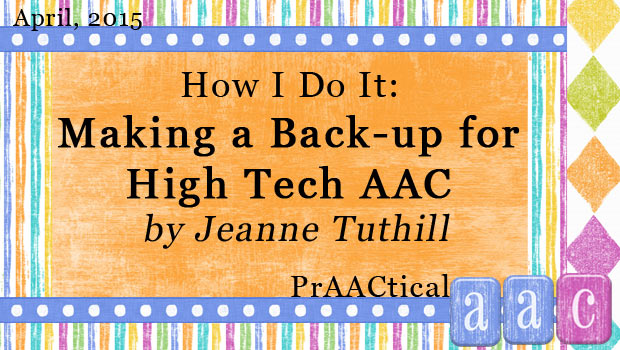
If you’ve ever woken up in the middle of the night sweating over one of your AAC clients who doesn’t have a back-up communication tool, then this post is for you. Jeanne Tuthill is back with another prAACtical suggestion, this time on the importance of ensuring that people with AAC needs have communication options when their technology isn’t available or appropriate. In keeping with the generous spirit of the AAC field, Jeanne also shares her files for this project. Enjoy! How I Do It: Making a Back-up for High Tech AAC Each time I teach my graduate class I try to invite at least one AAC user in as a guest speaker to share their story with the students in the class. It never ceases to fill my students with awe and appreciation for the challenges that AAC users face on a daily basis. My students often list it as... [Read More...]
March 29, 2015
by Carole Zangari -
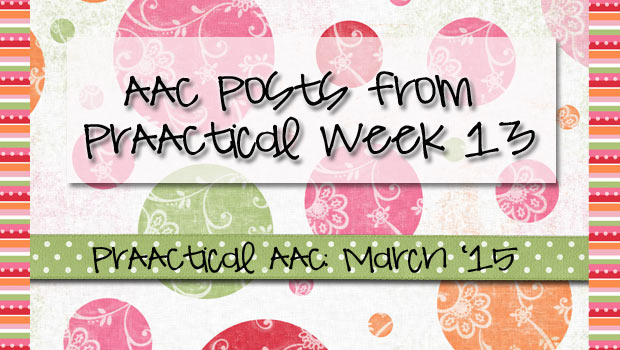
Monday: 5 Ways to Use Anchor Charts & Other Visual Supports in AAC Language Therapy Tuesday: PrAACtical Resources: Chronic Pain Assessment in Children with Disabilities Wednesday: Video of the Week – Lily Gets New Words! Thursday: Magic Moments with Toca Train by Nerissa Hall and Hillary Jellison
February 23, 2015
by Carole Zangari -

It’s been quite a while since we’ve done a Magic Moments post, and I’ve got a backlog of digital tools and tangible materials that we’ve used in our prAACtical therapy sessions and too little time to write about them. In this post, let’s look at word clouds. You may not be familiar with the term, but you certainly know them when you see them. Word clouds are images made from text. The larger the word in the image, the more frequently it appeared in the text. Here’s one made from the paragraph you are reading right now. Take a look to see which words are the largest and you’ll know which ones were repeated most often in this paragraph. There are lots of sites and apps that you can use to make word clouds and there are links to some of them at the end of this post. But, first, let’s... [Read More...]
October 14, 2014
by Carole Zangari -
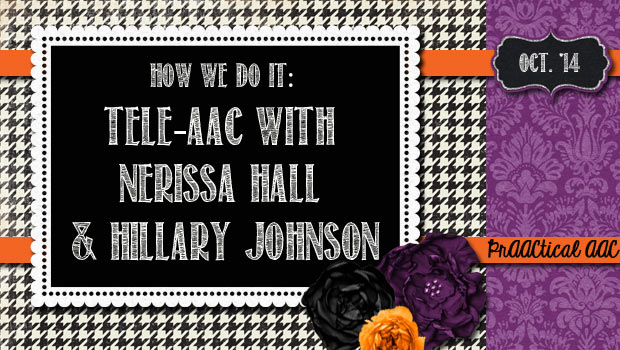
Have you been hearing a lot about telepractice lately and are wondering how that works when the client has AAC needs? In this post, we turn to Nerissa Hall and Hillary Jellison of Communicare who tell us how they use it in their clinical practice. Nerissa and Hillary are both SLPs and assistive technology practitioners specializing in AAC, AT, and telepractice/tele-AAC. They have worked together for a number of years and are the proud owners of Commūnicāre, LLC, organization based in Western Mass and CT, that offers intervention, consultation, and evaluation services focusing on supporting an individuals, or a team’s, success and independence through implementation of AAC, AT and innovative and evidence-based practices. We are committed to our clinical work, as well as translational research and are members of the C.A.R.E. Consortium. Tele-AAC: A Powerful Way of Supporting Individuals Using AAC Telepractice, which is used to provide professional services by linking clinicians... [Read More...]
September 18, 2014
by Carole Zangari -
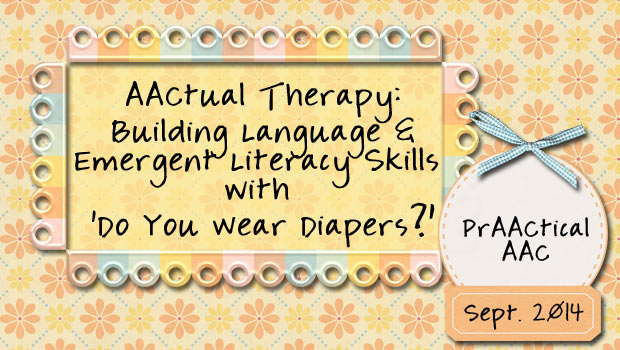
What’s more fun than using story books to teaching language to young children with AAC needs? Today, we hear from Kimberly Scanlon, an SLP practicing in New Jersey. Kimberley is is a devoted mom, wife and dog lover and blogs at Scanlon Speech and My Toddler Talks. She is the author of My Toddler Talks: Strategies and Activities to Promote Your Child’s Language Development and is finishing a unique picture and activity workbook, Learning to Read is a Ball. ::::::::::::::::::::::::::::::::::::::::::::::::::::::::::: Hold on to your undies, today we’re going to talk about poop, diapers, and the location of where various animals go potty. Sounds like a good time, right? Kidding aside, in this post I’m going to show you how to use this adorable picture book, Do You Wear Diapers? by Tanya Roitman to facilitate language and emergent literacy development in toddlers and preschoolers. What’s this book about? It’s a potty book! This adorable board book... [Read More...]
September 4, 2014
by Carole Zangari -
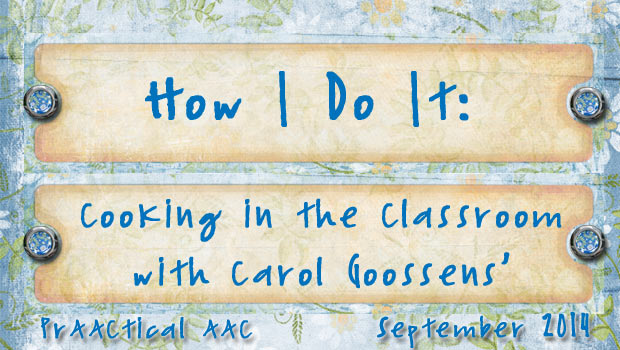
There is something about fall that puts us in the mood for cooking. Today, we are honored to learn from an AAC pioneer, Dr. Carol Goossens,’ who is an SLP and special educator based in the New York City area. She has consulted extensively in a variety of classrooms serving the full spectrum of children with special needs. Carol has presented both nationally and internationally about her collaborative work with teachers, therapists and families. She is known for her ability to seamlessly integrate technology in the classroom and for developing innovative ways to help children learn …while having fun doing it! In this post, she shares one of her latest projects, making animated recipes for using in cooking activities in the classroom. Cooking appears to be motivating for most children … the magic of putting together ingredients that ultimately become something delicious to eat. Teachers, speech-language pathologists (SLPs) and occupational therapists (OTs) often use food preparation activities... [Read More...]
July 10, 2014
by Carole Zangari -
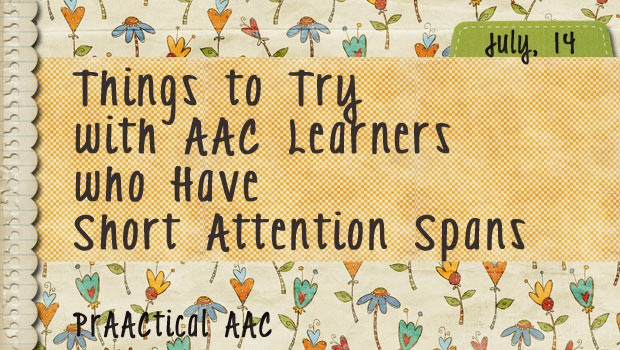
We love talking to AAC practitioners, hearing their stories, and picking up some tips along the way. Some conversations we love for the creative ideas or underlying passion. Others are memorable for less positive reasons. But still, they give us pause and challenge us to be better problem-solvers. “I love those ideas, but they won’t work with MY client: He doesn’t pay attention. He’s just not ready for all this. How do you expect me to teach someone with such a short attention span?” Glad you asked! First, don’t blame the learner. Like having short legs or frizzy hair, attention span is something over which some learners have little or no control. Their physiology is their physiology and they may not like it any more than we do. Use high-interest components in your therapy. The goals are the goals, but we can use things the client likes to make working on... [Read More...]
June 30, 2014
by Carole Zangari -
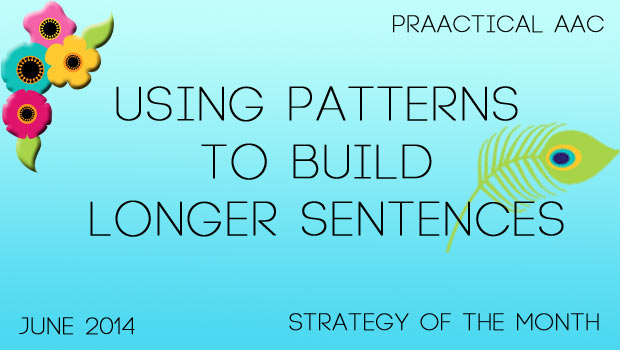
Throughout the month, we’ve been talking about building sentence length and complexity. We’ll end the month with a concept that applies to both beginning communicators and those with more complex language skills. Human beings are pattern-seekers. We notice similarities and distinctions, and compare things that are new to us to things we already know about. As we go through our lives, we draw on our pattern-seeking skills to learn about and understand the world. How can we use this intrinsic trait to help us in teaching language to AAC learners? Consider patterns when choosing your targets: Increasing sentence length is a broad goal that gives us lots of flexibility in how we design our intervention. We can lengthen sentences by adding descriptors, temporal terms, conjunctions, embedded clauses, and more. Within each category, there are many options. For a beginning communicator, we might teach descriptors related to appearance (e.g., size, color,... [Read More...]
June 23, 2014
by Robin Parker -
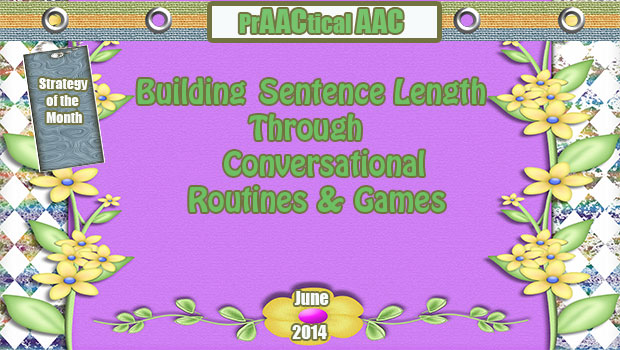
Building sentence length beyond the simple sentence level can be a lot of fun for those of us who love language. Additionally, and even more important, expanded sentences can provide communication impact and power to the communicator. Expanded sentences usually means moving from the simple to complex sentence. As Carole mentioned last week, we often begin with conjunctions like ‘because’, ‘but’, ‘so’, ‘if’, before’, after’. Here are some ideas for conversational routines and games that allow for frequent repetition with variety as well as strong communication power that will help with making it worthwhile to use longer sentences. “Pretty Please” Routine- This routine involves using ‘because’ to negotiate with longer sentences. This routine is reserved for requests that are possible but not always honored. In the case of teaching, we start with requests that can be honored if “pretty please because I worked hard or some other reasonable reason is... [Read More...]









